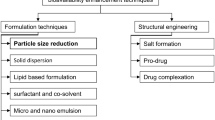Abstract
Size effects in phase transformations of nanoscale systems show up as significant changes in their phase diagram. Here, using a thermodynamic approach we demonstrate how the immiscibility region of Cr–W solid solutions is influenced by their particle size. For 40- and 70-nm-diameter particles, we consider two thermodynamically stable states with a core–shell configuration, differing in the composition of the core phase. It is shown that, in the nanometer range, one of these states becomes metastable and that the phase diagrams of the stable and metastable states differ significantly. Reducing the particle size leads to a decrease in the upper critical dissolution temperature (UCDP) by 300–400 K and marked changes in the mutual solubility of the components at temperatures comparable to the UCDP.
Similar content being viewed by others
References
Tanaka, T. and Hara, S., Thermodynamic evaluation of binary phase diagrams of small particle systems, Z. Met., 2001, vol. 92, no. 11, pp. 467–472.
Fedoseev, V.B. and Fedoseeva, E.N., Size effects during phase transformations in stratifying systems, Russ. J. Phys. Chem. A, 2014, vol. 88, no. 3, pp. 436–441.
Park, J. and Lee, J., Phase diagram reassessment of Ag–Au system including size effect, CALPHAD: Comput. Coupling Phase Diagrams Thermochem., 2008, vol. 32, no. 1, pp. 135–141.
Tovbin, Yu.K., Lower size boundary for the applicability of thermodynamics, Russ. J. Phys. Chem. A, 2012, vol. 86, no. 9, pp. 1356–1369.
Fedoseev, V.B., Splitting of the phase diagram of a stratified solid solution in micro-and nanosized systems, Phys. Solid State, 2015, vol. 57, no. 3, pp. 599–604.
Fedoseev, V.B., Shishulin, A.V., Titaeva, E.K., and Fedoseeva, E.N., On the possibility of the formation of a NaCl–KCl solid-solution crystal from an aqueous solution at room temperature in small-volume systems, Phys. Solid State, 2016, vol. 58, no. 10, pp. 2095–2100.
Hourlier, D. and Perrot, P., Au–Si and Au–Ge phases diagrams for nanosystems, Mater. Sci. Forum, 2010, vol. 653, pp. 77–85.
Ghasemi M., Zanolli Z., Stankovski M., Johansson J. Size-and shape-dependent phase diagram of In–Sb nano-alloys, Nanoscale, 2015, vol. 7, pp. 17387–17396.
Dahan, Y., Makov, G., and Shneck, R.Z., Nanometric size-dependent phase diagram of Bi–Sn, CALPHAD: Comput. Coupling Phase Diagrams Thermochem., 2016, vol. 53, pp. 136–145.
Guisbiers, G. et al., Cu–Ni nano-alloy: mixed, core–shell or Janus nano-particle?, Nanoscale, 2014, vol. 6, no. 24, pp. 14630–14635.
Diagrammy sostoyaniya dvoinykh metallicheskikh sistem: spravochnik (Phase Diagrams of Binary Metallic Systems: A Handbook), Lyakishev, N.P., Ed., Moscow: Mashinostroenie, 1996, vol.2.
Udovskii, A.L., Karpushkin, V.N., and Nikishina, E.A., A method for autonomous thermodynamic assessment of phase diagrams of binary systems containing p disordered phases of variable composition and q phases of constant composition at (p, q) = 10, Metally, 1991, no. 4, pp. 87–103.
Voronin, G.F. and Belov, G.V., Racchet fazovykh ravnovesii s ispol’zovaniem termodinamicheskikh baz dannykh (Assessment of Phase Equilibria Using Thermodynamic Databases), Moscow: Mosk. Univ., 2014.
Yurov, V.M., Laurinas, V.Ch., Guchenko, S.A., and Zavatskaya, O.N., Size effects and surface tension of pure metals, Usp. Sovrem. Estestvoznaniya, 2012, vol. 7, pp. 88–93.
Tyson, W. and Miller, W., Surface free energies of solid metals. Estimation from liquid surface tension measurements, Surf. Sci., 1977, vol. 62, no. 1, pp. 267–276.
Fedoseev, V.B., Potapov, A.A., Shishulin, A.V., and Fedoseeva, E.N., Size and shape effect on the phase transitions in a small system with fractal interphase boundaries, Eurasian Phys. Tech. J., 2017, vol. 14, no. 1 (27), pp. 18–24.
Fedoseev, V.B., Use of fractal geometry in thermodynamic description of three-dimensional crystal structure elements, Pis’ma Mater., 2012, vol. 2, no. 2, pp. 78–83.
Fedoseev, V.B. and Perepelkina, I.M., Effect of grain size on defect density, Prikl. Mekh. Tekhnol. Mashinostroeniya, 2008, no. 1 (12), pp. 51–56.
Author information
Authors and Affiliations
Corresponding author
Additional information
Original Russian Text © A.V. Shishulin, V.B. Fedoseev, 2018, published in Neorganicheskie Materialy, 2018, Vol. 54, No. 6, pp. 574–578.
Rights and permissions
About this article
Cite this article
Shishulin, A.V., Fedoseev, V.B. Size Effect in the Phase Separation of Cr–W Solid Solutions. Inorg Mater 54, 546–549 (2018). https://doi.org/10.1134/S0020168518050114
Received:
Published:
Issue Date:
DOI: https://doi.org/10.1134/S0020168518050114




